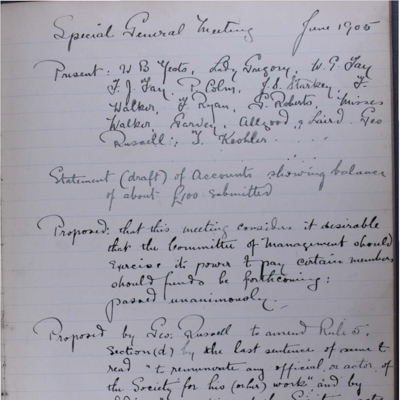
The Abbey Theatre minute books contain notes from meetings of the theatre’s Board of Directors. They offer a fascinating glimpse behind the scenes of the theatre, showing how the Abbey’s managers dealt with a variety of issues, from choosing plays to determining how much to pay their actors.
Along the way, we find important information about leading figures from the Irish Literary Revival and beyond: not just W. B. Yeats, Lady Gregory and John Millington Synge but Sean O’Casey, Lennox Robinson, Teresa Deevy, Sean O’Faolain, Frank O’Connor, and many others. We also learn about great Irish actors such as Molly Allgood, Ria Mooney, Barry Fitzgerald, Cyril Cusack and many more.
The minute books allow us to understand better how theatres are run. Yeats wrote about his approach to theatre business in a poem that was tellingly called “The Fascination of What’s Difficult”, cursing “plays/ that have to be set up in fifty ways”. Here we find Yeats encountering all sorts of difficulties - from the threat of government censorship of Sean O’Casey’s The Plough and the Stars in 1926 to the leaking of his late play Purgatory to a Jesuit priest in 1938. And those difficulties are indeed fascinating.
We also learn much about the day to day activities of keeping a theatre in business: the struggles to find appropriate funding, the actors’ requests for extra money or time off, and the maintenance of the building.
And of course we learn much about Ireland, both before and after independence. The Abbey Theatre famously was the first state-subsidised theatre in the English-speaking world, earning funding in 1925 from the newly independent Irish Free State. With that money came an evolving relationship with the Irish government, the Irish language, and the Catholic Church.
In total, the Abbey Theatre and NUI Galway are making available seven minute books, with details as follows:
- 1904 - 1905: outlining the foundation of the theatre, its relationships with other theatres in Ireland, and its evolving approach to its actors and patron Annie Horniman.
- 1908 - 1912: This minute book is primarily a record of plays to be performed as the theatre moves through the period. It also details actors’ issues, training and staging practicalities.
- 1912 - 1939: This book contains minutes of the company’s annual general meetings, and thus is different from the other publications, with some overlap in the minute books from 1929-39.
- 1925 - 1931: After a hiatus, the Abbey Theatre Board of Directors resumes taking minutes in 1925, following the Free State government’s decision to fund the theatre. A central topic of debate here is the fate of Sean O’Casey’s The Plough and the Stars.
- 1932 - 1936: The theatre grapples with ongoing financial difficulties, responds to the death of Lady Gregory, and its actors are offered the opportunity to make movies in Hollywood. Ernest Blytheformally joins the Board.
- 1936 - 1937: While covering a relatively short period, this minute book gives a fascinating account of the Abbey’s relationship with Teresa Deevy. We also find growing tensions between the Board and the Abbey company of actors.
- 1937 - 1939: Dominated by negotiations with the Irish government for the creation of a new theatre, which would house the Abbey Theatre and Gate Theatre (the outbreak of war in 1939 meant that this plan was never completed). Also notable here is the production of Yeats’s final plays, in particular the controversial Purgatory, which appeared at the Abbey Theatre Festival in 1938.


